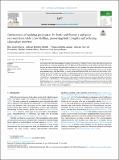Por favor, use este identificador para citar o enlazar a este item:
http://hdl.handle.net/10261/282840COMPARTIR / EXPORTAR:
 SHARE SHARE
 CORE
BASE CORE
BASE
|
|
| Visualizar otros formatos: MARC | Dublin Core | RDF | ORE | MODS | METS | DIDL | DATACITE | |

| Título: | Optimisation of working parameters for lactic acid bacteria and yeast recovery from table olive biofilms, preserving fruit integrity and reducing chloroplast recovery |
Autor: | López-García, Elio CSIC ORCID ; Benítez-Cabello, Antonio CSIC ORCID ; Martín-Arranz, Virginia CSIC; Garrido Fernández, A. CSIC ORCID ; Jiménez Díaz, Rufino CSIC ORCID ; Arroyo López, Francisco Noé CSIC ORCID | Palabras clave: | Biofilms Lactic acid bacteria Metataxonomic analysis RSM Table olives |
Fecha de publicación: | 15-ago-2022 | Editor: | Elsevier | Citación: | LWT - Food Science and Technology 166: 113787 (2022) | Resumen: | The study of the table olive biofilms is usually achieved using a stomacher which causes the physical rupture of pitted olives in an osmotic media but does not differentiate between those on the surface and inside the fruits. Besides, the high amount of eukaryotic DNA released from the vegetable cells makes the further molecular study of the detached microbiota complex. This work applies Response Surface Methodology, based on a D-optimal experimental design and glass beads, to recover lactic acid bacteria (LAB) and yeasts from the biofilm of fermented olives without crushing the flesh. The RSM showed that the best simultaneous results were obtained by shelling the olives, at 8 °C, with glass beads (6 mm diameter) in a 0.16 (w/w) bead/olive ratio for 15 min at 330–400 rpm. Its application recovered lower LAB (possibly because of excluding those in the flesh), but similar yeast counts to the stomacher. The metataxonomic analysis of total DNA from biofilms showed that the glass bead-based protocol reduced the chloroplast sequences and improved the genera assignation for bacteria (16S) and yeast (ITS). The new non-destructive procedure enhances biofilm studies and may allow validating table olives as a carrier of probiotic microorganisms. | Descripción: | 10 Páqginas.-- 5 Figuras.-- 5 Tablas | Versión del editor: | http://dx.doi.org/10.1016/j.lwt.2022.113787 | URI: | http://hdl.handle.net/10261/282840 | DOI: | 10.1016/j.lwt.2022.113787 | ISSN: | 0023-6438 |
| Aparece en las colecciones: | (IG) Artículos |
Ficheros en este ítem:
| Fichero | Descripción | Tamaño | Formato | |
|---|---|---|---|---|
| LWT_2022_V166_113787.pdf | Artículo principal | 3,43 MB | Adobe PDF |  Visualizar/Abrir |
CORE Recommender
SCOPUSTM
Citations
3
checked on 25-abr-2024
WEB OF SCIENCETM
Citations
2
checked on 25-feb-2024
Page view(s)
29
checked on 27-abr-2024
Download(s)
40
checked on 27-abr-2024
Google ScholarTM
Check
Altmetric
Altmetric
Este item está licenciado bajo una Licencia Creative Commons

